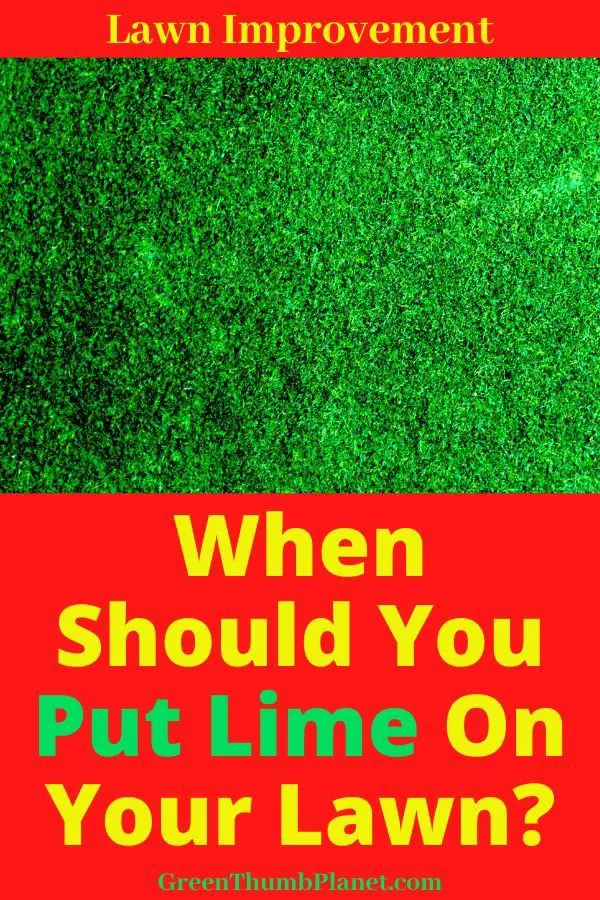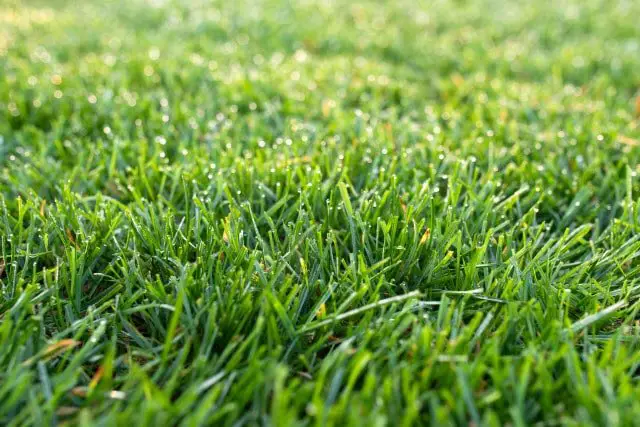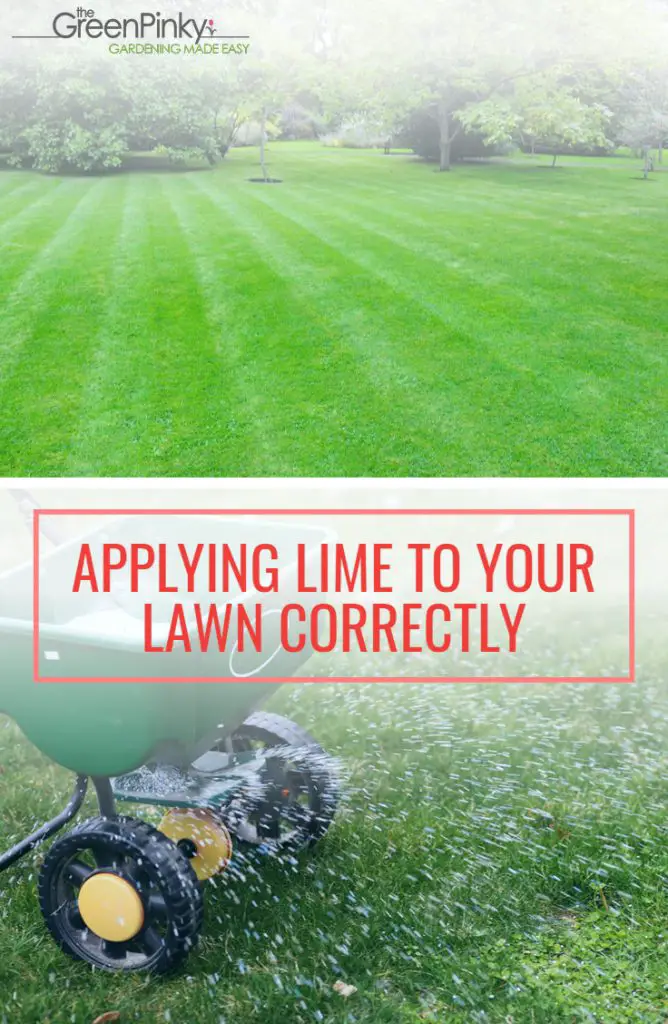Can You Put Lime On Your Lawn Anytime
Lime can be applied to a lawn any time of year that soil isnt frozen, but it is typically done during spring or fall. Its best to apply lime after aerating the lawn. This aids absorption and allows some of the lime to reach deeper into the soil. Retest your soil each year until its pH level is satisfactory.
The Right Timing For Liming
Be sure to consult your soil test results in order to determine your lawns liming requirement. Because lime benefits soil , it is best to apply a treatment before grass is planted. For new lawns, test your soil and add any necessary lime before you put down seed. Spring and fall are the appropriate times to apply lime on already-established lawns as long as the soil is not frozen or covered in frost.
How And When To Add Lime
Youll begin to see a measurable difference in the soil pH about four weeks after adding lime, but it can take six to twelve months for the lime to dissolve completely. You wont see the full effect of adding lime to the soil until it is completely dissolved and incorporated into the soil.
For most gardeners, fall is a good time to add lime. Working lime into the soil in the fall gives it several months to dissolve before spring planting. To add lime to the soil, first prepare the bed by tilling or digging to a depth of 8 to 12 inches . Spread the lime evenly over the soil, and then rake it in to a depth of 2 inches .
Also Check: What’s The Best Lawn Seed To Use
Why Wont It Grow
If you notice that your lawn is not showing signs of healthy growth or vigor after fertilization, you may have a pH balance problem. Keep in mind that alkaline soil can cause the same issues as an acidic one. Therefore, always perform a test on the ground so you are sure about the pH level and what methods to apply accordingly.
Tips For Liming Aeration And Seeding

Lime works well with aeration and seedingcombining liming and aeration can give you a head start in the spring, creating a perfect environment for new seeds. Here are some things that can help you get started:
- Use this rule of thumblime should be applied at a rate of 40 pounds per 1000 square feet.
- Apply lime to your yard at the same time you are sowing new seeds.;
- Make sure to seed at the recommended rate and to keep the grass seed moist and water daily to keep the grass seed from drying out.
- We recommend double aerate at cross angles, pulling plugs that are around 3″-4″ in length.
- Afterward, leave the plugs alone so they will break apart, and do not collect the lawn clippings.
- Avoid using spiked shoes for aeration. The spike will compact the soil even further.
You May Like: Natural Clover Killer
What Are The Benefits Of Putting Lime On Your Lawn
First of all, you should be aware that not all lawns will benefit from putting lime on it and some lawns will never need to be treated with lime to alter the pH level.
If you have tested your soil or have hired a professional to test and apply lime then there are a number of benefits you will see for your lawn, however it wont be immediate and it will more than likely be several months before you start to see any change.
- You should start to notice less weeds growing as weeds normally only take over where the soil is not ideal for grass, making your soil ideal for thriving grass will naturally result in fewer weeds.
- After you have applied lime to your lawn you will see the benefit of fertilizer being highly effective again, this means adding fertilizer will not seem like a waste of time anymore you will see a benefit.
The Benefits Of Applying Lime To Your Lawn
The soil under your lawn is full of critical macronutrients that will help your lawn grow. Nutrients such as potassium, phosphorus, nitrogen, iron, boron, zinc, and many others. There has to be a perfect balance of these nutrients if you want to have a luscious green lawn. When the pH of the soil goes above 6.5, a breakdown of nutrients occurs that can cause a nutrient deficiency. When there is a deficiency, not only will your lawn fail to thrive, the soil can become toxic and actually cause it to die out completely.
One way to tell if your soil may be acidic is if you notice withering grass blades, yellow patches in the grass, sod that is slow-knitting, or a general reduction in the density of the turf. Acidity can be caused by any number of external factors. Too much rain can cause the alkaline to run off which will cause an increase of acidity, or it can even be caused by over-fertilization. Whatever the cause, your lawn will benefit from a lime application.
Recommended Reading: Causes Bare Spots Lawn
When Should You Apply Lime
Early spring is a great time for lime and fertilizer applications. Again, its important to test your soils pH first. If you havent planted grass seed yet, apply lime first to make your soil a better host for the grass seed. Ask your lawn care professional to test your soil and recommend the right products for your turf.
Your soil will probably require regular lime applications for a few years to achieve an optimal pH level. The good news is that once you hit the right pH, maintaining that level often calls for less frequent lime applications.
You Experience Excessive Rainfall
Whether its an atypically wet winter on the west coast, a barrage of storms in the south, or a boggy spring in the northeast, excessive rainfall can result in the need to add lime to your lawn.
Water naturally pulls calcium and magnesium from the soil, which results in a more acidic pH. If youve had intense weather patterns in recent years or live in a region that experiences heavy precipitation, youll need to add lime to your lawn to combat rising soil acidity.
Don’t Miss: Advertise Lawn Care Business
Can I Apply Lime And Iron At The Same Time
The interaction of Calcium and Lime is bad enough that an overapplication of Lime alone can tie up the Iron in the soil and create a condition called Lime-Induced Chlorosis, where plants or a lawn turn yellow this is why we leave 90 days between applications and split Lime applications up over time, instead of all May 6, 2014.
What Is Lime Treatment For Lawns
Lime for lawn care can actually help reverse the effects of damaging elements found in grass, including aluminum, iron and manganese. The calcium specifically has a sort of regulating effect on other soil nutrients such as copper, phosphorous and zinc, all of which can have damaging effects and inhibit growth.
There are a number of industries, entities and people that use a lime lawn application:
- Turf farmers
You May Like: Thistledown Weed Killer
Lime For Lawns Reduces Soil Acidity
- Pin
Soil pH, an important element in proper plant care, is a measure of its relative acidity or alkalinity. For most plants to thrive, the pH level needs to be in the range of about 6 to 7, which is just slightly acidic. A lower pH level, indicative of very acidic soil, is problematic because it prevents plants from absorbing nutrients. In a soil with a very acidic pH of 4.5, for example, it is estimated that about 70 percent of applied fertilizer is wasted because plants can’t make use of it. If your soil is too acidic, you can add agricultural lime for lawns; when applied systematically as a soil amendment, it can work to adjust the overall soil pH away from the acidic side and back toward neutral pH.
When And How Do I Apply Lime

Throughout the U.S. and Canada, the best time to apply lime is in the spring or fall. In northern locations, applying lime in October or November before the ground freezes will allow rain to work it into the soil. The snow melt and freeze/thaw cycle during the spring will also help work it into the ground.
Your soil test will likely make a recommendation on how much lime to apply based on your pH value. Soils that are slightly acid could require 25 to 50 lbs. per 1,000 sq. ft. annually. You can split this up into two applications if you prefer, one in the spring and another in the fall.
Lime can be messy to apply if you buy the cheap stuff. Pay a little more for pelletized dolomitic lime. It will be easier to apply with your broadcast spreader, and will add calcium and magnesium to your lawn while raising your soils pH.
Read Also: Can Geese Smell
Why You Should Lime Your Lawn In Spring
Although it may not feel like it in many parts of our great country, it is, technically, officially spring in Canada. We made it, folks! Lawn care season is just around the corner.
;Early spring is an ideal time to lime your lawn, and is a great way to further improve your soil after;performing a core aeration on your lawn.;If your lawn is wilted or dormant, never apply lime; instead, wait for a time when the lawn is actively growing like early spring or fall.
Regular liming can do a wealth of good for your grass. With a number of benefits, calcitic lime is;a welcome addition for every home lawn, especially those that need a little TLC.
With baseball starting and Easter coming fast, it’s hard to deny that spring is here.;That means it’s time to start mentally preparing for the lawn care season, even if your grass won’t see any action for a few weeks yet.;
Here’s why spring is the perfect time to lime your lawn
Balance Soil pH;
When soil is acidic, it becomes extremely hard to;grow healthy grass. As the soil acidity gets worse, plant essential nutrients become unavailable for the plant to uptake, such as nitrogen, phosphorus and potassium – the three macro nutrients required for healthy growth. Neutralizing soil pH effectively frees up these essential nutrients, giving your lawn a better chance;to thrive.
Lime On Lawn: Does Your Grass Need Lime Treatment
You may have heard one of your parents or grandparents or the gardener down the street who has the best looking flowers and lawn say, You got to add lime to sweeten the soil! In many cases that is true, but not for every lawn or landscape. Its important to determine the pH of the soil before adding any amendments to the lawn. pH levels that are below a scale of 6.5 are considered acidic while pH levels that are above a scale of 7.0 are considered alkaline. Neutral pH is from a scale of 6.5 to 7.0.
When soils are tested, and show that they are in the acidic range, adding lime is the appropriate soil amendment to add. If soils are in the alkaline range, then sulfur should be added. A soil test from a university extension service or accredited soil test lab is the best way to determine the current pH level. In most cases, these labs will also provide the amount of lime or sulfur needed per 1,000 sq. ft. to adjust the pH level.
There are do-it-yourself pH test kits that come with litmus paper that will provide an approximate pH level based on a color chart. These are not very accurate and may or may not provide information on how much lime or sulfur to apply.
Also Check: I Put Too Much Oil In My Lawn Mower
Can Lime Kill A Lawn
The good news is that if you have overdosed your lawn with a lime application you probably wont kill.
The pH level of your lawn will now spike massively which will make your grass unhealthy and it will probably turn yellow for a while.
If you want to partake in a battle of chemicals you could apply sulfur as that will lower the pH level of your lawn but its up to you whether you want to have a battle of chemicals on your lawn.
If you have overdosed your lawn with lime the best solution I feel is just to wait and ride it out and give it regular water as that will help flush the excessive lime out.
So the good news is you wont completely kill your lawn but you will cause it damage that will last for a while.
Maybe its best to get professionals in when its time to put lime on your lawn.
Do You Need To Lime Your Lawn Grass
Do you need to lime your lawn grass? Heres a hint that may help you determine if you need lime lawn treatment: If you live in a dry, desert climate, theres a chance your soil is alkaline and you may not need to lime your lawn grass. If you live a rainy area where acid-loving plants such as rhododendrons and camellias thrive, your soil is likely acidic and may benefit from lime lawn treatment.
The only way to find out for sure is to take a soil test . Liming a lawn that doesnt need it is a waste of time and money, and liming soil that is already highly alkaline may affect soil health and result in a sickly, yellow lawn.
Test every year to be sure you arent adding too much lime. Once the proper pH is established, you will probably need to lime only once every few years.
You May Like: Where To Find Craftsman Lawn Mower Model Number
When To Add Lime To A Lawn
Lime can take several months after application to break down and change your soil pH. A good time to test your lawns pH and adjust it is when your soil begins to warm in the spring. Lime can also be applied in the fall. The benefit of adding lime to your soil in fall is that both the freeze-thaw cycles and the abundant rain and snow common during the fall and winter months will help break down the lime and start raising the soils pH. Lime should never be applied to a lawn that is stressed or dormant.
What Are The Signs Of Too Much Lime On Your Lawn
The main thing you will notice if you have added too much lime to your lawn is the fact it is now turning yellow.
If you have added too much lime you may have raised the pH level from a low level that is acidic up to a high level that is alkaline and ideal level for grass is a natural level of around 6-7 pH.
If you have added too much lime to your lawn then the problem is probably caused by your grass getting a lack of nutrients it requires.
For grass to thrive and grow green it needs to have access to iron, potassium, and nitrogen if you have added too much lime to your lawn the grass wont be able to access these vital nutrients and it will start to turn yellow if it is lacking even just one of these nutrients.
To find out the best time of year to add lime to your lawn
Read Also: Herbicide For Wild Violets
When Should I Lime My Lawn
The best time for a lawn lime application in Charlotte is during the fall or winter. Most landscape professionals will test soil pH in spring and then apply lime in winter or fall. Lime can take several months to break down and change soil pH after being used. Since you add lime during the colder months, it can work into the soil and change the soil pH before the roots become active in spring.;
If you add lime during the warmer months of the year, it can damage the lawn. You always want to add lime before the warmer spring weather. In fact, the fall and winter freeze-thaw cycles, as well as the winter wet season, help break down lime so it becomes part of the soil.
If your lawn is already stressed, do not add lime. It will further damage the grass. The same rule applies to a dormant lawn.
What Happens If You Put Too Much Lime On Lawn

So you have added lime to your lawn expecting it to be the answer to all your problems and it to turn your lawn into the beautiful lush green that people advise you it would. The opposite has happened you have added lime to your lawn and it is actually deteriorating and becoming a worse condition and before you added lime to your lawn.
In this article, I am going to answer the question of what happens if you put too much lime on your lawn.
Read on and you will find out why you should be careful when you decide to add lime to your lawn and what to do if you have messed up and added too much lime.
When you put too much lime on your lawn it will not be able to absorb the nutrients it needs to stay healthy and it will quickly start to turn yellow. You need to add horticultural sulfur to counter this problem or you can wait it out and it will fix itself after several months.
Recommended Reading: How To Get Rid Of Geese On Lawn
